The Intel Broadwell Desktop Review: Core i7-5775C and Core i5-5675C Tested (Part 1)
by Ian Cutress on June 2, 2015 7:45 AM ESTGaming Benchmarks: Mid-Range
Shifting gears, let's take the iGPU out of the equation and look at gaming from a CPU perspective, By moving up to higher-end video cards, we can being to see how Broadwell stacks up in CPU-bound gaming scenarios.
Alien: Isolation
If first person survival mixed with horror is your sort of thing, then Alien: Isolation, based off of the Alien franchise, should be an interesting title. Developed by The Creative Assembly and released in October 2014, Alien: Isolation has won numerous awards from Game Of The Year to several top 10s/25s and Best Horror titles, ratcheting up over a million sales by February 2015. Alien: Isolation uses a custom built engine which includes dynamic sound effects and should be fully multi-core enabled.
For low end graphics, we test at 720p with Ultra settings, whereas for mid and high range graphics we bump this up to 1080p, taking the average frame rate as our marker with a scripted version of the built-in benchmark.
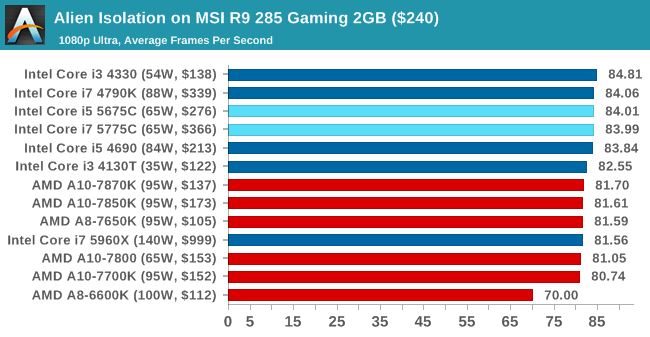
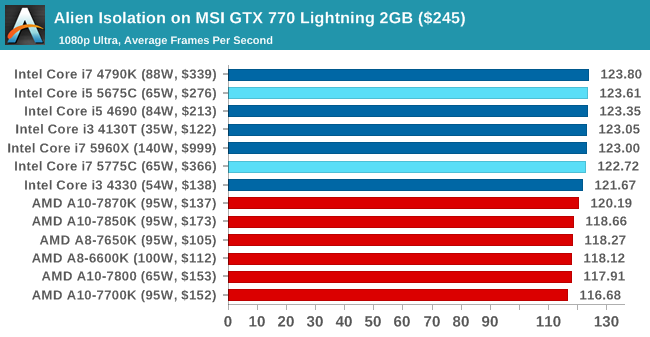
Total War: Attila
The Total War franchise moves on to Attila, another The Creative Assembly development, and is a stand-alone strategy title set in 395AD where the main story line lets the gamer take control of the leader of the Huns in order to conquer parts of the world. Graphically the game can render hundreds/thousands of units on screen at once, all with their individual actions and can put some of the big cards to task.
For low end graphics, we test at 720p with performance settings, recording the average frame rate. With mid and high range graphics, we test at 1080p with the quality setting. In both circumstances, unlimited video memory is enabled and the in-game scripted benchmark is used.
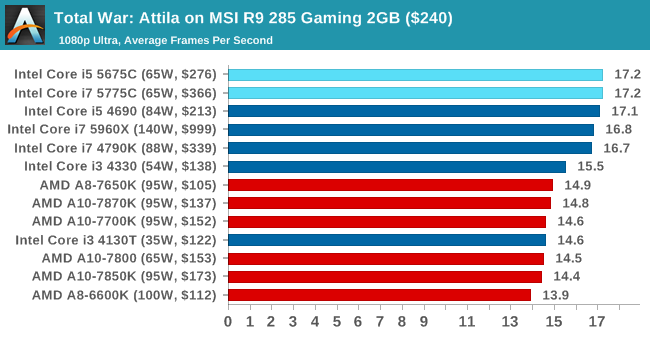
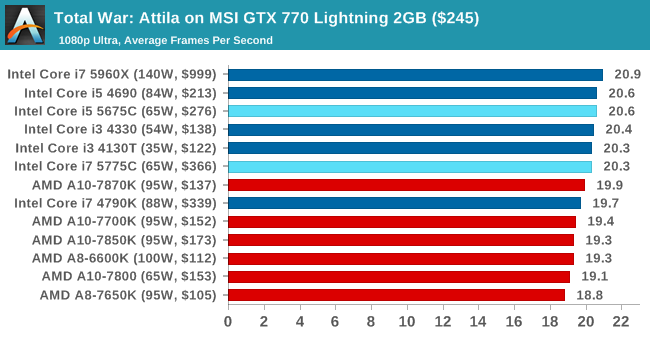
Grand Theft Auto V
The highly anticipated iteration of the Grand Theft Auto franchise finally hit the shelves on April 14th 2015, with both AMD and NVIDIA in tow to help optimize the title. GTA doesn’t provide graphical presets, but opens up the options to users and extends the boundaries by pushing even the hardest systems to the limit using Rockstar’s Advanced Game Engine. Whether the user is flying high in the mountains with long draw distances or dealing with assorted trash in the city, when cranked up to maximum it creates stunning visuals but hard work for both the CPU and the GPU.
For our test we have scripted a version of the in-game benchmark, relying only on the final part which combines a flight scene along with an in-city drive-by followed by a tanker explosion. For low end systems we test at 720p on the lowest settings, whereas mid and high end graphics play at 1080p with very high settings across the board. We record both the average frame rate and the percentage of frames under 60 FPS (16.6ms).
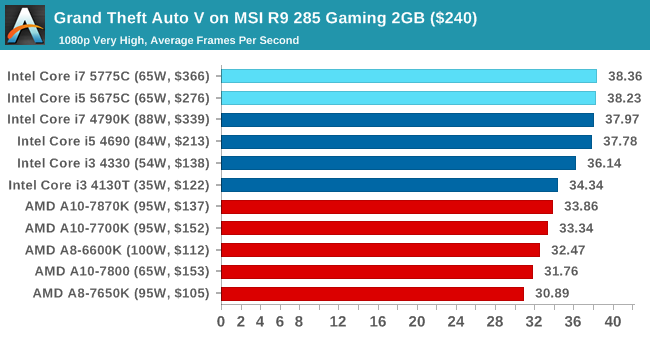
![Grand Theft Auto V on MSI R9 285 Gaming 2GB ($240) [Under 60 FPS]](https://images.anandtech.com/graphs/graph9320/74957.png)
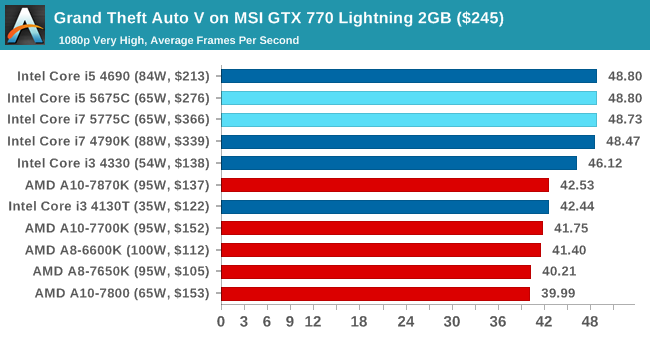
![Grand Theft Auto V on MSI GTX 770 Lightning 2GB ($245) [Under 60 FPS]](https://images.anandtech.com/graphs/graph9320/74967.png)
GRID: Autosport
No graphics tests are complete without some input from Codemasters and the EGO engine, which means for this round of testing we point towards GRID: Autosport, the next iteration in the GRID and racing genre. As with our previous racing testing, each update to the engine aims to add in effects, reflections, detail and realism, with Codemasters making ‘authenticity’ a main focal point for this version.
GRID’s benchmark mode is very flexible, and as a result we created a test race using a shortened version of the Red Bull Ring with twelve cars doing two laps. The car is focus starts last and is quite fast, but usually finishes second or third. For low end graphics we test at 1080p medium settings, whereas mid and high end graphics get the full 1080p maximum. Both the average and minimum frame rates are recorded.

![GRID: Autosport on MSI R9 285 Gaming 2GB ($240) [Minimum FPS]](https://images.anandtech.com/graphs/graph9320/74959.png)
Middle-Earth: Shadows of Mordor
The final title in our testing is another battle of system performance with the open world action-adventure title, Shadows of Mordor. Produced by Monolith using the LithTech Jupiter EX engine and numerous detail add-ons, SoM goes for detail and complexity to a large extent, despite having to be cut down from the original plans. The main story itself was written by the same writer as Red Dead Redemption, and it received Zero Punctuation’s Game of The Year in 2014.
For testing purposes, SoM gives a dynamic screen resolution setting, allowing us to render at high resolutions that are then scaled down to the monitor. As a result, we get several tests using the in-game benchmark. For low end graphics we examine at 720p with low settings, whereas mid and high end graphics get 1080p Ultra. The top graphics test is also redone at 3840x2160, also with Ultra settings, and we also test two cards at 4K where possible.
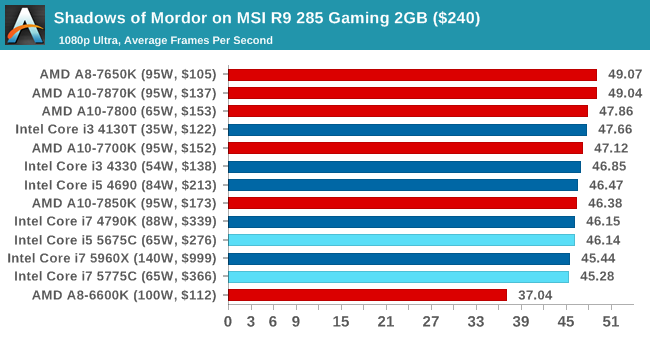
![Shadows of Mordor on MSI R9 285 Gaming 2GB ($240) [Minimum FPS]](https://images.anandtech.com/graphs/graph9320/74961.png)
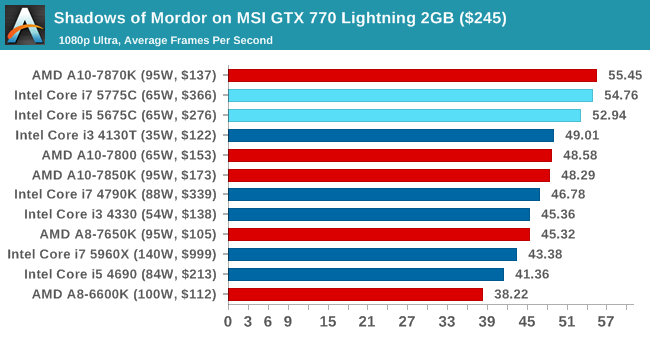
![Shadows of Mordor on MSI GTX 770 Lightning 2GB ($245) [Minimum FPS]](https://images.anandtech.com/graphs/graph9320/74971.png)
Shadows of Mordor at 4K, Single GPU
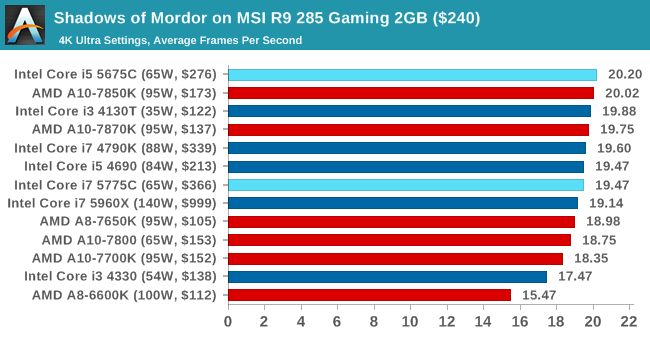
![Shadows of Mordor on MSI R9 285 Gaming 2GB ($240) [Minimum FPS]](https://images.anandtech.com/graphs/graph9320/74963.png)
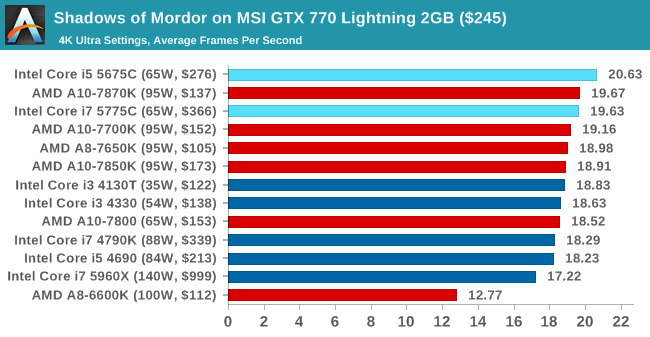
![Shadows of Mordor on MSI GTX 770 Lightning 2GB ($245) [Minimum FPS]](https://images.anandtech.com/graphs/graph9320/74973.png)
Conclusions on Mid-Range Graphics
With the Intel iGPU removed from the picture, what we're seeing here is the combination of Broadwell's architecture improvements, and the Crystal Well eDRAM functioning as an L4 cache for the CPU cores. The biggest benefit here Broadwell-DT was with the R9 285 for GRID on minimum frame rates, showing 75.6 for the 4790K vs 80.06 for the 5775C. Otherwise performance overall is not all that different from what we already see with the best Haswell CPUs, however it's a bit surprising that the Broadwell CPUs don't fall behind, given their rather sizable frequency deficit versus the i7-4790K.















196 Comments
View All Comments
Zingam - Wednesday, June 3, 2015 - link
Well, nothing to see here! Move along, sir!Where is the Skylake?
ryrynz - Wednesday, June 3, 2015 - link
Ian, what driver was used? Intel just released a new one with some significant performance improvements (15.36.21.4222) Retest?Phartindust - Wednesday, June 3, 2015 - link
Please fix the graphs for GRID Min frames, or did the A10-7700k really beat everything else by 10fps?unityole - Thursday, June 4, 2015 - link
"due to time constraint we will save overclocking for part 2" care to explain why both you and tomshardware don't do OC? i have a feeling intel not allowing reviewers to do OC at first for sample, until at least few weeks or even months later.can't blame you though, need to continuously get sample from intel.
unityole - Thursday, June 4, 2015 - link
im extremely interested in OC, voltage used, power consumption and also performance is what we're after, before moving onto skylake.Notmyusualid - Thursday, June 4, 2015 - link
I'll second the request for identical-speed benchmarks too, thanks.albert89 - Thursday, June 4, 2015 - link
I've got to say I like what Intel has done to its iGPU side of the APU no matter how you read this review it actually doesn't look good for them. Overall Broadwell from these results seems to be between 1.5-3 times more expensive than AMD and if that doesn't both you, then its performance in the games above was between 1.6-6 points ahead while in one game beating AMD by 10 points (not good) while AMD beating Intel by 10 fps (nice). And don't forget we are comparing AMD (28nm) against Intel (14nm) which casts a not so flattering picture of Intel. And need I mention the latency gain over AMD, hardly to write home about by Intel. If your an all round user or a gamer the only thing you'll notice from Broadwell is the hole in your wallet.unityole - Thursday, June 4, 2015 - link
true that, most people here are for CPU performance though, doesn't hurt to have additional good IGPU in case of discrete dies on you, can still boot without dGPU and iGPU can still do things at 1080p.NvidiaWins - Thursday, June 4, 2015 - link
Literally no gain over Devils' Canyon.......zodiacfml - Friday, June 5, 2015 - link
Interesting. I could see a particular niche for this for users needing very good cpu performance and wants occasional gaming that is better than an entry level graphics card. Can't wait for overclocking results.I hope prices go down with Skylake's...